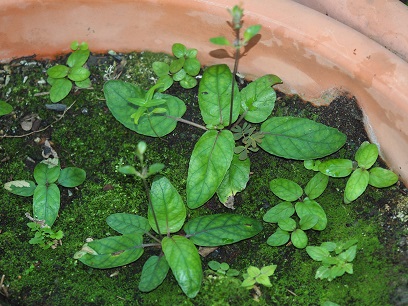| Home | Nature Weekly Index |
24 May 2020 | Naming of Plants | Red Flame | Strobilanthes reptans |
 I had already written about Red Flame back in
February 2016. Recently, I discovered its accepted
botanical name was changed from Hemigraphis reptans to Strobilanthes reptans, though I did know
when it actually took place. After some digging online, the change probably had to do with a 2004 publication
[1]. As the story went, a group of researchers did a genetic study of the plants within the Strobilanthinae
group where the genera Strobilanthes and Hemigraphis belong. Their findings led them to propose
a single expanded genus Strobilanthes rather than continuing with the current few genera within the group.
After verifying the information from an authoritative website,
Global Biodiversity Information Facility (GBIF), I had made the same
migration of the names in my website as well.
I had already written about Red Flame back in
February 2016. Recently, I discovered its accepted
botanical name was changed from Hemigraphis reptans to Strobilanthes reptans, though I did know
when it actually took place. After some digging online, the change probably had to do with a 2004 publication
[1]. As the story went, a group of researchers did a genetic study of the plants within the Strobilanthinae
group where the genera Strobilanthes and Hemigraphis belong. Their findings led them to propose
a single expanded genus Strobilanthes rather than continuing with the current few genera within the group.
After verifying the information from an authoritative website,
Global Biodiversity Information Facility (GBIF), I had made the same
migration of the names in my website as well.
The official way of naming plants (i.e. assigning botanical names) is a relatively complex business. It is governed by the International Code of Nomenclature for algae, fungi, and plants (ICN) which is based on a two-name (binomial) system. Each plant has a first name (genus name) and a last name (epithet name); the combination of the two formed the unique species name of the plant. This species name then become the recognized botanical name of that plant throughout the world regardless of its common name(s). Before the era of genetics, plants were classified based on their physical features. Now, some experts prefer to group them based on their genetic commonality. Sound straightforward but not exactly because botanists might not always agree with each other and they do change their mind over time. Placing a plant in another group would normally mean a change to its species name.
To establish the accepted name of a plant, the inventor (or author) of the name has to publish it officially. If there were more than one botanical names for a plant, the earliest published one should be the accepted version. This is where the complexity starts for a novice like me.
 In a botanical name, the author’s name is placed after the botanical name. If there is a change in the botanical
name later, the original author’s name will be placed within parentheses. Taking the example of Red Flame, the
original accepted name Ruellia reptans G.Forst was published back
in 1786. Thereafter, changes to the classification of this plant
took place and its name became Hemigraphis reptans (G.Forst.) T.Anderson ex Hemsl.
in 1885 before eventually became Strobilanthes reptans
(G.Forst.) Moylan ex Y.F.Deng & J.R.I.Wood
in 2011. The "ex" denotes that the
initial species name description did not satisfy the ICN rules for valid publication but the same plant name was
subsequently validly published by another author. I will not attempt to dwell deeper since there are a lot of
information out there to explain this naming business.
In a botanical name, the author’s name is placed after the botanical name. If there is a change in the botanical
name later, the original author’s name will be placed within parentheses. Taking the example of Red Flame, the
original accepted name Ruellia reptans G.Forst was published back
in 1786. Thereafter, changes to the classification of this plant
took place and its name became Hemigraphis reptans (G.Forst.) T.Anderson ex Hemsl.
in 1885 before eventually became Strobilanthes reptans
(G.Forst.) Moylan ex Y.F.Deng & J.R.I.Wood
in 2011. The "ex" denotes that the
initial species name description did not satisfy the ICN rules for valid publication but the same plant name was
subsequently validly published by another author. I will not attempt to dwell deeper since there are a lot of
information out there to explain this naming business.
Authors' name come in handy when 2 different plants shared the same species name. For example, Ruellia reptans G. Forst. is a synonym of Strobilanthes reptans while Ruellia repens L. is a different wild herbaceous plant that is also very common here.
Historically, Red Flame was listed as Hemigraphis primulifolia, one of its current synonyms in the 2009 Singapore Flora Checklist. The authors back then probably had a different opinion on its botanical name. In addition, the plant was presumably an escapee from the Singapore Botanic Gardens back in 1950 [2] before it started to spread like wildfire across the country.
On a side note, I came across someone selling a pot of this plant online (Shopee) under the name Hemigraphis primulifolia for S$7.90 which I thought was way over priced since this wild plant could be found almost everywhere here.
References:
[1] Moylan EC, Bennett JR, Carine MA, Olmstead RG, Scotland RW. Phylogenetic relationships among Strobilanthes s.l. (Acanthaceae): evidence from ITS nrDNA, trnL-F cpDNA, and morphology. Am J Bot 2004;91(5):724-735. | Read article |
[2] Kiew R, Tan JPC. Stop That Weed! UTAR Agriculture Sci J 2016;2(2):53-60. | Read article |